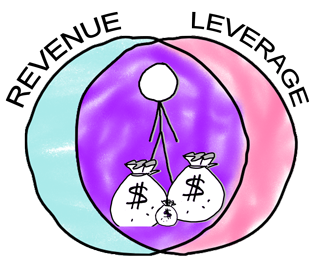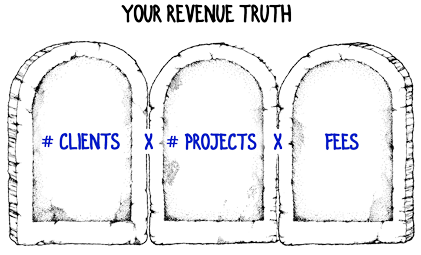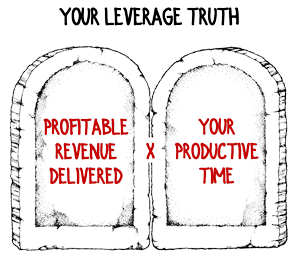If you want your consulting practice to be more lucrative*, there are five paths to achieve that goal. Or, said otherwise, there are five possible bottlenecks holding you back. If you can identify and break open your current bottleneck, you’ll advance to the next level of financial freedom.
*Long-time readers know I define wealth as relationship strength. However, to lure in folks less familiar with me, today I stated “wealth” in the headline while writing about financial affluence.
Consulting is a very simple business. We win projects and deliver them profitably. While eating chocolate.
There’s virtually no limit to how much revenue a consultant can win (based on my work with many consultants) or chocolate a consultant can consume (based on personal experience). Delivery, on the other hand, hits a ceiling fairly quickly. That’s why leverage is critical.
As an individual consultant or a firm leader, your “wealth venn” consists of increasing revenue and leverage.

Answering just a handful of diagnostic questions will reveal the truth about how financially fruitful your firm is. Let’s break down each side of your business. Use the diagnostic questions to identify your own bottlenecks.
Your Revenue Truth
Your revenue is the product of a three-part equation. I’ve illustrated the parts on tablets because they’re like the ten commandments. Only, these are easier to remember.

Path #1: More Clients
A solo consultant should always have at least five, sizable clients. A boutique should double that number.
Diagnostic question: Do you have a broad enough client base or is the (bulk of) your revenue coming from one or two or three clients?
Path #2: More Projects per Client
Follow-on work is the easiest work to win. Studies suggest it’s eight times easier to win business from an existing customer than from a new customer. If your work is good (and it is good, right?) I’m sure you’ve found follow-on business to be your easiest sale.
Diagnostic questions: Is your repeat rate high? Is your repeat rate high?** Are most of your clients signing up for additional projects?
Path #3: Higher Fees per Project
If your average project size increases from mid-five-figures to mid-six figures or seven-figures, your revenue goes up by an order or two of magnitude. (Astounding math courtesy of Carnegie Mellon.)
Diagnostic questions: Are you maximizing the size of every project? Are you optimizing the fees and margins on every assignment?
Your Leverage Truth
Leverage is a two-part equation. Still using tablets.

Path #4: Deliver More Revenue (Profitably) per Hour of Your Time
Across the entire consulting industry (including mega firms), the average consultant delivers $250,000 in revenue each year.
That’s the average. I know consultants who feel overwhelmed with $75,000 worth of work on their plates. I have also worked with independent consultants who deliver upwards of $10 million per year (by leveraging teams, of course).
Diagnostic questions: Which side of the spectrum are you on? Are you at capacity or could you double the revenue you deliver profitably?
Path #5: More, Productive Time
Some people are morning people, working like marines while the rest of us slumber; others come alive as the sun is setting and work furiously into the wee hours.
If your daily surge of productivity is just prior to lunch and lasts about fifteen minutes, your revenue delivery potential is apt to be limited. Particularly as a solo consultant or leader of a small boutique.
Diagnostic questions: What percentage of your work hours are productive? Are large chunks of your work days spent handling administrivia, managing low priority tasks and numbly attempting to create progress? Or are you eagerly engaging in a dozen new-business conversations, gracefully handling clients, energetically consuming Toblerones, and efficiently directing your team to produce value?
I’ve helped consulting firms excel on all five paths and, from what I’ve seen, bottlenecks are far more common in some areas than others.
Which of the five paths do you want to work on most? Which would make the biggest difference for you and your firm?
Text and images are © 2024 David A. Fields, all rights reserved.

 David A. Fields Consulting Group
David A. Fields Consulting Group 

Good stuff David
For us, price(fees) was the key. We held prices higher than others. While our utilization may have been a little lower we were able to spend more time on developing innovative offerings – that commanded a higher price point and differentiated us. Once you give on price with a client it’s very tough to ever get it back
Excellent example, Bob. Many consultants are afraid to hold the line on a fee premium; yet, if you win half the business with twice the fees, you’re making as much money and working half as hard. Plus, with higher fees you have room to delight your client so that they keep coming back and give referrals. It’s a win all around. Thank you for contributing the case study on your firm’s success, Bob.
Leverage is what’s there for me to work on. I love my accounting profession so much that it’s easy for me to jump at solving any problem that crosses my path instead of focusing on high-impact problems or developing the requests into opportunities to solve high-Impact problems.
I’ve gotten a lot better at this since working with you, and I can still become more masterful in this area. One thing that this easier is that now I have some equally geeky experts on my team, so I can let them gleefully solve problems, too, while I suss out the high impact.
Leverage is one of the two most common bottlenecks for solo consultants and small boutiques, so you’re not alone, Jaime. Letting go, systematizing, productizing, and trusting others all contribute to improving your leverage. In your case, I believe that you already saw a major increase in fees per project, which has allowed you to focus on other bottlenecks. I appreciate you wading into this discussion.
David: I always enjoy your writing.
In this instance you may have overlooked, as most do, the fullest definition of leverage. Leverage does not necessarily mean that you must continue to pursue a labor-intensive consulting practice. In fact, one of the very best ways to become really wealthy in consulting is to find the means of packaging your intellectual knowledge and experience into a tangible “product” that you can then sell to clients that allows them to do for themselves, that which they might otherwise have needed a consultant to do for them.
And it is so much easier then walking in and saying “Hi, I’m David Fields, how do you like me so far?” Rather, you are now able to walk in and say, “I suspect from my experience in serving your industry that you are facing a challenging issue. I have something here that can help you solve that. May I show it to you?”
Patrick, thanks for your comment. Not only does it warrant a specific clarification, it creates an opportunity to look at a bigger question.
First, the clarification: one of the components of leverage is “Revenue Profitably Delivered.” That does not mean labor-intensive work. Any method or approach that profitably delivers customer value for the revenue received counts.
You’ve brought up a more central question which I chose not to delve into in this particular article: What is consulting? There are plenty of definitions and the boundaries of what constitutes consulting are certainly fuzzy. I tend not to include pure product sales (i.e., anything that is not customized to the client) in consulting. Products are definitely a way to produce an outstanding revenue stream, and I encourage practitioners to consider products; however, it’s not a consulting revenue stream and in this article I wanted to stick with consulting.
As I said, though, this is fuzzy. Between pure products and 100% customized solutions are a range of offerings that increase leverage by systematizing and productizing your offerings. (See my earlier comment to Jaime Campbell.)
David:
I certainly concur with all of your points here.
Over my 30+ years of consulting I’ve seen all kinds of different approaches. I’ve seen many, from solos to huge firms engage in compiling research and presenting the client with some written report and they call that consulting. And not how I would define it, but perhaps that is. (reminds me of the old joke of the consultant as seagull – flies in, circles your head a few times and drops something white in your hands. You think it’s a report, only later to find out what it really is!)
That all said, your article was entitled “Ways To Become Wealthy.” I was merely sharing one way in which I accomplished that goal and would recommend others give serious thought to. Packaging knowledge also serves as a very meaningful differentiator in a world where everyone calls themselves a consultant.
You’re absolutely right, Patrick. Product sales can be an excellent revenue stream and a path to wealth. Thanks again for highlighting it.
Please help me understand the full meaning of the statement: “If your average project size increases from mid-five-figures to mid-six figures or seven-figures, your revenue goes up by an order or two of magnitude.”
So far I see that if average project size increases by a factor of 10, so does the revenue. This is a trivial math, assuming that the same company can handle added complicacy of a 10x bigger project.
Do I miss something here?
You’re right on the mark, Anatoli. It is trivial math. Hence, the tongue-in-cheek, parenthetical comment about Carnegie Mellon that followed.
The point is that if you increase your project size, you grow. I worked with a firm up in Boston that typically closed projects in the $200k-$500k range. Within a couple of years, their typical project was over $1 million. That was a successful path to wealth and one that is very achievable for most consultants.
Increasing size of successfully delivered projects by 2-5x involves much more than being able to sell projects of this size, partners/employees, project management, risk management, etc. To me it becomes chicken and egg situation all over again.
Anatoli, 99% of the time it is FAR easier for most consultants to to deliver a 5x project than to sell one. Hence, this is not a chicken and egg situation where it’s unclear which skill set and activity come first.
In my work with consulting firms over the years, I have seen exactly one case of a firm successfully building capacity ahead of demand and many, many cases of pre-building capacity backfiring. The path to wealth in this case is sound: learn to win much larger projects. Even if your margin declines slightly (it should increase), you’ll end up with more dollars in your pocket.
Thank you, David. Your experience will be my inspiration. I hear that “everybody wants to partner with a guy who has a project with paying client”. Based on your advice to price project based on a ” badly beaten straw man” I am working through a Context Document for a project with a major company right now. So far – so good. It takes a leap of faith. Faith in your framework.
Anatoli, let me know how it goes. Even if this one doesn’t land, give yourself credit for having an outstanding opportunity. That said, I’m hopeful you’ll have a victory story to share.